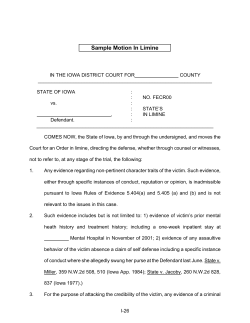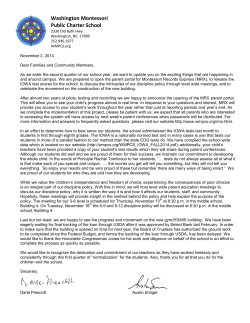
Iowa`s volatile weather story - On
March 26, 2015 View past issues By Easton Kuboushek, ISA communication specialist Iowa’s volatile weather story Spring"and"Summer"Rainfall"In"Iowa"(1893;2014)" Spring & Summer Rainfall in Iowa, 1893-2014 1;in;20;yr"return"in"1893;1980"has"1;in;4;yr"return"in"1981;2014" 20" 1893;1980" 1981;2014" Jul$Aug'Precipita0on'(inches)' July-August Precipitation (inches) 1893;1980"Average" 1981;2014"Average" 15" Weather volatility in Iowa has increased over the past 20 years and for several reasons, augmented volatility is expected to continue. Chris Anderson, Ph.D., climate risk analyst, Iowa State University (ISU) has dedicated his research to past and future climate trends and their effects on soybean management practices. 2010 2014 10" 2008 5" 2013 2012 0" 0" 5" 10" 15" May$Jun'Precipita0on'(inches)' May-June Precipitation (inches) Last year had the hottest average global temperature ever recorded – but not in Iowa. While the media clings to the world’s warmest year, Iowa’s story is pouring in a different direction. Iowa’s weather story, especially in the last decade, has come in the form of a lot of rain at the wrong times – especially in the spring. According to historical data, between 1873 and 1980 Iowa experienced 20" an abnormally wet spring once every ten years. Figure 1: The data illustrated in this chart show average inches of rainfall in Iowa from 1893-2014. Points outside the yellow circle fall above the average rainfall in inches from 1981-2014. Since 2008, Iowa has experienced five years with above average rainfall – a probability of 1:175,000. Since 1980 – that number has jumped to once every three. “It’s not just that it’s been a little bit rainier, it’s that we’ve had more extreme springs than we have ever had in the past,” Anderson explained. Anderson continued to illustrate the anomaly Iowa has experienced to more than 50 farmers at the 2015 ISA Research Conference in February. “Not only have we seen a 300 percent increase in abnormally wet springs, we have experienced them three consecutive years,” Anderson said. Based on historical data, that is a probability of 1:8,000. What’s more, when years 2008 and 2010 are included, Iowa experienced an above average spring rainfall five out of seven years – a probability of 1:175,000. Not exactly a figures to bet the farm on. Yet growers are forced to face Mother Nature head on and adapt management practices to address our volatile climate. Making sense of Mother Nature Anderson, in conjunction with the ISA On-Farm Network®, seeks to take the complex rainfall and weather terms to usable terminology for use on the farm. “The data that are being collected by ISA and being aggregated, can give you some clues when there is an emerging trend like this that you have to adapt to,” Anderson said. In his effort to describe the linkages between climate trends and soybean management practices, Anderson worked to expand the list of weather indices and associated impacts on field management, developed field-level rather than state-level or county-level statistical relationships and computed trends and other temporal changes in the weather indices in 2014. His work was published in two prior Advance articles to date, How Midwest growers are managing an increase of rainfall volatility and Weather-based N Application Probability Tools. Anderson’s research and collaboration has been and will continue to be invaluable to ISA and the Iowa soybean farmers. For permission to republish articles or to request high-res photos contact Dorothy Tate, dtate@iasoybeans.com © 2015 Iowa Soybean Association On-Farm Network®. All rights reserved. On-Farm Network® is a registered trademark of the Iowa Soybean Association, Ankeny, IA. Portions of some On-Farm Network trials are paid for in total or in part by the soybean checkoff Iowa Soybean Association | On-Farm Network | 1255 SW Prairie Trail Pkwy | Ankeny | IA | 50023 | US
© Copyright 2025









